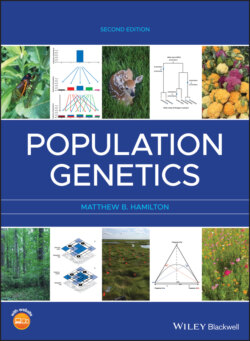Читать книгу Population Genetics - Matthew B. Hamilton - Страница 14
Parameters and parameter estimates
ОглавлениеWhile developing the expectations of population genetics in this book, we will most often be working with idealized quantities. For example, allele frequency in a population is a fundamental quantity. For a genetic locus with two alleles, A and a, it is common to say that p equals the frequency of the A allele and q equals the frequency of the a allele. In mathematics, parameter is another term for an idealized quantity like an allele frequency. It is assumed that parameters have an exact value. Put another way, parameters are idealized quantities where the messy, real‐life details of how to measure the quantities they represent are completely ignored.
Empirical population genetics measures quantities such as allele frequencies to give parameter estimates by sampling and then measuring the alleles and genotypes present in actual populations. All experiments, observations, and even simulations in population genetics produce parameter estimates of some sort. There is a subtle notational convention used to indicate an estimate, that is, the hat or ^ character above a variable. Estimates wear hats whereas parameters do not. Using allele frequency as an example, we would say (pronounced “p hat”) equals the number of A alleles sampled divided by the total number of alleles sampled. Intuitively, we can see from the denominator in the expression for that the allele frequency estimate will depend on the sample we gather to make the estimate.
In actual populations, a parameter has a true value. For the allele frequency p, knowing this true value would require examining the genotype of every individual and counting all A and a alleles to determine their frequency in the population. This task is impractical or impossible in most cases. Instead, we rely on an estimate of allele frequency, , obtained from a sample of individuals from the population. Sampling leads to some uncertainty in parameter estimates because repeating the sampling and parameter estimate process would likely lead to a somewhat different parameter estimate each time. Quantifying this uncertainty is important to determine whether repeated sampling might change a parameter estimate by just a little or change it by a lot. When dealing with parameters, we might expect that p + q = 1 exactly if there are only two alleles with allele frequencies p and q. However, if we are dealing with estimates, we might say the two allele frequency estimates should sum to approximately one ( + ≈ 1) since each allele frequency is estimated with some errors. The more uncertain the estimates of and , the less we should be surprised to find that their sum does not equal the expected value of one.
Parameter: A variable or constant appearing in a mathematical expression; a value (usually unknown) used to represent a certain population characteristic; any factor that defines a system and determines or limits its performance.
Estimate: An indication of the value of an unknown quantity based on observed data; an approximation of a true score, parameter, or value; a statistical estimate of the value of a parameter.
It could be said that statistics sits at the intersection of theoretical and empirical population genetics. Parameters and parameter estimates are fundamentally different things. Estimation requires effort to understand sampling variation and quantify sources of error and bias in samples and estimates. The distinction between parameters and estimates is critical when comparing actual populations with expectations to test hypotheses. When large, random samples can be taken, estimates are likely to have minimal errors. However, there are many cases where estimates have a great deal of uncertainty, which limits the ability to evaluate expectations. There are also instances where very different processes may produce very similar expected results. In such cases, it may be difficult or impossible to distinguish the different potential causes of a pattern due to the approximate nature of estimates. While this book focuses mostly on parameters, it is useful to bear in mind that testing or comparing expectations requires the use of parameter estimates and statistics that quantify sampling error. The Appendix provides a review of some basic statistics that are used in the text.
